Jazira Field Trip 2004
Jazira Field Trip 2004
Wadi Jazira is one of the most popular destinations for the Al Ain chapter.
We try to visit the oasis each season to see the different crops in season and
follow the evolution of the oasis.
When the group first began visiting Jazira, there was no road; members had to
hike to the site from the end of the track from Khabbayn. Today, a graded track
provides easy access, and with the track have come visitors and garbage.
Despite the track, the family that farms the oasis has had difficulty keeping
workers employed. Because Jazira has no commerce, no electricity and no
telephone service, few want to reside there or work there. A few years ago, the
oasis declined because of neglect but there has been a change in the past two
years with signs of regular activity.
Nearby is the popular swimming pool. Like the oasis itself, the swimming area
has become widely known and with its popularity the inevitable littering. On two
occasions, the group has chosen Jazira for its annual wadi clean up and on each
occasion hauled five or six truckloads of garbage from the area.
Jazira features 'the mother of all mango trees', a large collection of banana
plants, interesting housing, a small graveyard that includes aloe vera plants, a
mud-and-stone weir, wild orchids, and our favorite orange trees!
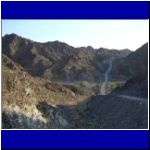
The road in to Jazira crosses two summits |
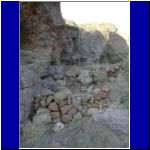
Some of the constructions in the valley are recent |
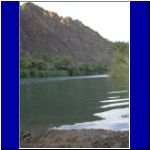
The water supply for the oasis is plentiful |

Grasses, bullrushes and wild date palms grow along the bank |
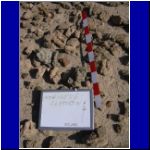
Like many of our destinations, Jazira includes a copper smelting site |
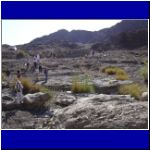
The oldest ruins and the smelter are located near the parking area |
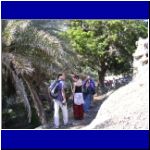
There are two access routes into the oasis; this one follows the falaj |

The spreading arms of this mango cover the mosque and three houses |
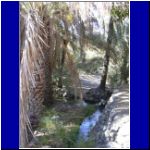
The uppermost part of the oasis is almost exclusively for dates |
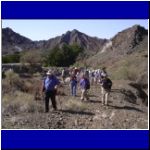
Geoff leads the group around the houses to the graves |

Just beyond the graves is where we placed our motion activated cameras to
photograph fox |
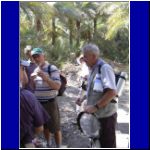
Mike (right) with his net and flask of coffee |

The banana grove is always popular with the photographers |

Fruit and blossoms of the banana plant |
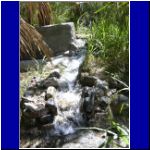
Water was rushing through the falaj during this visit to Jazira |

Geoff pointing out some of the more unsual plants cultivated at Jazira |
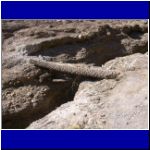
The footbridge over the gorge at the opposite end of the oasis |

We almost lost Phil one day when the bridge began to collapse as he crossed |

Today the oasis workers have added fresh palm trunks to the foot bridge |
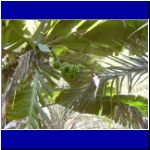
The small, sweet bananas are also grown at Jazira |

This insect trap is one of several strategies to combat pests |
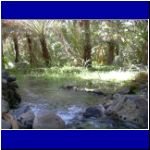
The reservoir in the center of the oasis was filled with water for this visit |
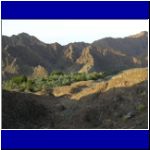
The view from the second summit |

This Kodak moment has been recorded by hundreds of members |

Late afternoon is an ideal time to catch the deep colors on the mountains
surrounding Jazira |
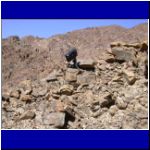
One of our motion activated cameras was knocked askew by a fox |
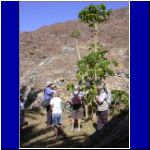
Geoff discussing the papaya grown at Jazira |

This lovely date storage jar was the last of the large pots left at Jazira;
others were all stolen |

On our next visit to the oasis, this pot was broken. The pieces were
reassembled by the Al Ain Museum |
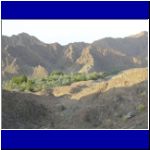
View from the summit under different light conditions |
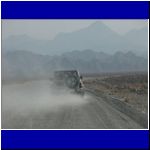
Following Brien's Nissan on the dusty track into Jazira |
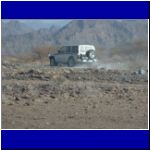
The track from Khabbayn cuts across several small wadi systems |
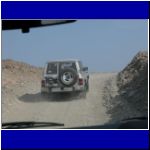
Parts of the track are washed out with each rainfall |

Members make their way through the mountains |

Imagine making this traverse on foot! |
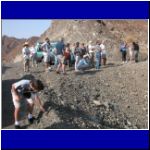
Members gathered at the summit for the introduction to Jazira |

Jazira is aptly named as it is an island of green in the mountains |
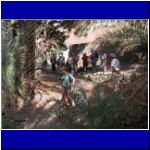
At the mosque |
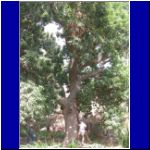
The mother of all mango trees! |

Trying to estimate the diameter of the tree |
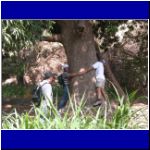
The tree has lost several large branches in recent years but is still a good
producer |
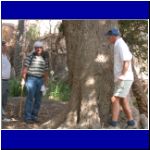
(From left) Will, Brien and Geoff |

Brien attempts to measure the tree |

Dates, oranges, limes, lemons, figs and bananas are among the produce
cultivated at Jazira |

At the footbridge |

The gorge is narrowest at the bridge |
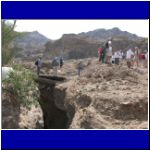
Water can be heard and seen at the bottom of the gorge |
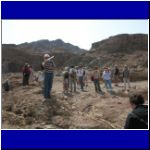
Brien points to the site of the swimming hole from the bridge |
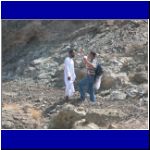
Brien and one of the men who now manage the oasis |
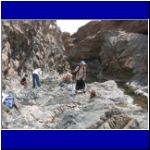
At the swimming hole, members prepare for a relaxing swim |
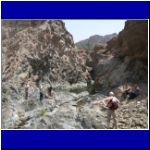
There is a small waterfall at the end of the pool |
|


















































